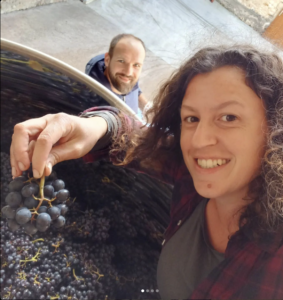Marion Perseval

Marion Perseval
About
Owner & winemaker: Marion Perseval
Vineyards: 1.26ha across four parcels in the village of Chamery
Vineyard management: Certified organic
Soils: Clay or silt over limestone
Grapes grown: Chardonnay, Pinot Noir, Pinot Meunier
Annual production: 10,000 bottles
Quick facts:
- Historically, the domaine belonged to the family of Marion’s father, Gérard. Marion is a sixth-generation vigneron. Her grandparents, Jacques and Elisabeth, raised animals in addition to growing grapes. The last cow pastures were eventually replaced by vineyards as time went on.
- “My favorite moments are those which I spend in the company of my dog Jaja, in contact with nature in the middle of my vineyards, especially in spring when the colors are soft in the first rays of the sun.” – Marion Perseval
After six years studying and working in the field of dental prosthetics, Marion Perseval realized she missed the vineyards she grew up around. As the sixth generation of a grape-growing family, she’d spent her childhood working amongst the vines alongside her parents, who always brought her with and had her participate in all of the seasonal tasks. The timing was perfect, as her brother, Clément, had just established his own domaine and needed some extra help–she had the opportunity to support her sibling while learning the ropes herself.
Marion took over the rest of the family parcels in 2019, and her first order of business was obtaining organic certification. Unlike most domaines in Champagne, the family’s farming practices had been close to organic for decades. When Marion’s father Gérard took over from his parents in the 1980s, he began growing cover crops in the vineyards–a stark departure from the thoroughly-herbicided bare vineyards still common in Champagne. He saw only positives in its effects on biodiversity, soil quality, and erosion, so he began incorporating environmentally-respectful practices from that point onwards.
The vineyards are found in the village of Chamery, which is distinguished by the natural amphitheater formed by the hills around the village. This unique formation acts as a barrier against strong storms and rain and maximizes sun exposure–a benefit in cool wet years, but less advantageous in years with excessive heat and drought.
In the cellar, Marion works with as little intervention as possible, neither fining, nor filtering, nor cold stabilizing the wines. Since the project is still new, she has started with a line of blended cuvées, with the intention of moving towards single-parcel bottlings in the future. For the parcel-specific vinifications, she is experimenting with more spontaneous fermentations with indigenous yeasts, and using fermenting musts from the harvest for the prise de mousse. Riddling of all the bottles is still done manually.

